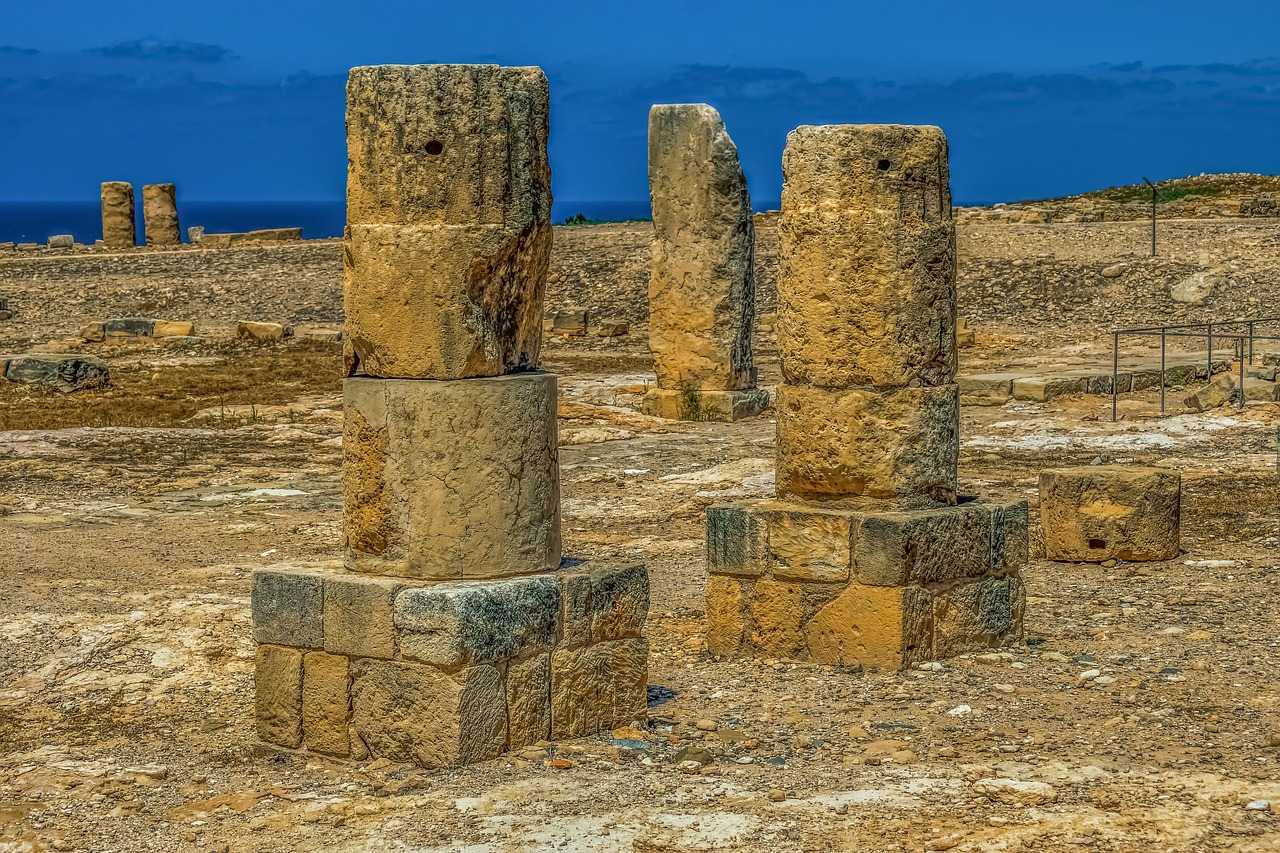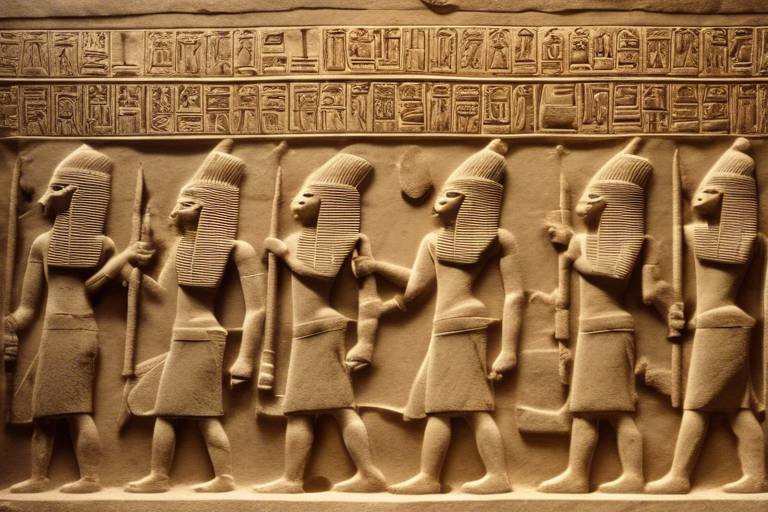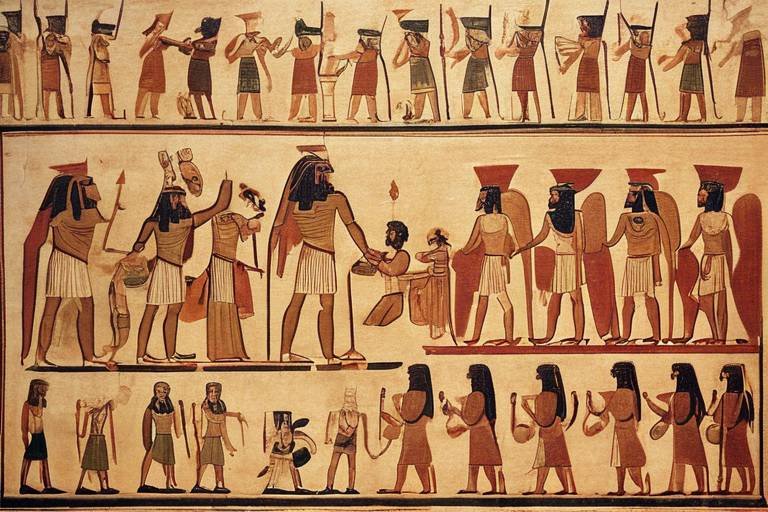The Decline of the Kushite Kingdom - Causes and Implications
As we delve into the intriguing history of the Kushite Kingdom, we uncover a tale of grandeur and eventual downfall. The decline of this once-mighty empire was not a sudden event but a culmination of various factors that eroded its strength over time. From internal struggles to external invasions, economic challenges to cultural changes, the causes of the Kushite Kingdom's decline are multifaceted and deeply intertwined.
One of the primary reasons behind the decline of the Kushite Kingdom was the internal strife and political instability that plagued its governance. Power struggles among the ruling elite, conflicting interests, and weakened central authority all contributed to the fragmentation of the kingdom, sowing the seeds of its eventual demise.
External invasions and military defeats also played a significant role in the downfall of the Kushite Kingdom. Constant incursions by neighboring powers, coupled with strategic vulnerabilities in its defenses, left the kingdom exposed and unable to withstand the onslaught of foreign conquest.
Furthermore, economic challenges and the decline of key trade routes dealt a severe blow to the prosperity of the Kushite Kingdom. Disruptions to commerce, dwindling resources, and a faltering economy weakened the kingdom's financial foundation, further exacerbating its decline.
Religious and cultural changes within the Kushite Kingdom also contributed to its unraveling. Shifts in belief systems, societal norms, and cultural practices led to internal discord and a loss of traditional identity, weakening the social fabric that had once bound the kingdom together.
Migration patterns and population shifts further reshaped the demographic landscape of the Kushite Kingdom, altering power dynamics and societal structures. These demographic changes, coupled with the other factors at play, ultimately hastened the decline of this once-proud empire.
Despite its eventual fall, the legacy of the Kushite Kingdom endures through its contributions to art, architecture, and literature. The influence of the Kushites on subsequent civilizations in Africa and beyond echoes through the annals of history, a testament to the enduring impact of this ancient empire.
Today, modern perspectives on the Kushite Kingdom continue to evolve as new archaeological discoveries shed light on its history and significance. Ongoing research offers fresh insights into the rise and fall of this enigmatic empire, enriching our understanding of the ancient world and the forces that shaped it.

Historical Background of the Kushite Kingdom
The Kushite Kingdom held a significant position in ancient Africa, renowned for its power, influence, and cultural achievements. Originating from the region of Nubia, the kingdom expanded along the Nile River, establishing a prosperous civilization that flourished for centuries. The Kushites excelled in architecture, art, and literature, leaving a lasting legacy that influenced subsequent civilizations.
One of the pivotal moments in Kushite history was the conquest of Egypt by King Piye, marking the beginning of the Twenty-Fifth Dynasty and the Kushite rule over Egypt. This period, known as the Kushite or Nubian Dynasty, showcased the kingdom's military prowess and political dominance in the region. The Kushites integrated Egyptian culture with their own, creating a unique blend of traditions that defined their kingdom.
Throughout its history, the Kushite Kingdom faced various challenges, including conflicts with neighboring powers such as the Assyrians and Persians. Despite these external pressures, the Kushites maintained a strong cultural identity and continued to thrive through trade and diplomacy. The kingdom's strategic location along the trade routes of the ancient world contributed to its economic prosperity and cultural exchange.
Notable rulers like King Taharqa and Queen Amanirenas played crucial roles in shaping the Kushite Kingdom's history, leading military campaigns, expanding territories, and fostering intellectual and artistic achievements. The kingdom's capital, Napata, served as a center of religious worship and political administration, reflecting the Kushites' reverence for their gods and commitment to governance.
As the Kushite Kingdom reached its zenith, it stood as a beacon of civilization and innovation in Africa, attracting scholars, traders, and travelers from distant lands. The kingdom's cultural achievements, such as the construction of pyramids and temples, highlighted its advanced architectural and engineering skills, leaving a mark on the landscape that endures to this day.

Internal Struggles and Political Instability
Internal Struggles and Political Instability within the Kushite Kingdom played a pivotal role in its eventual decline. The kingdom, once known for its strong rulers and centralized power, began to face challenges from within that gradually weakened its governance structure. Power struggles among the ruling elite and competing factions led to internal conflicts that sowed seeds of discord within the kingdom.
As political instability took root, the ability of the Kushite rulers to maintain control over their vast territories became increasingly compromised. The once unified kingdom found itself fragmented, with different regions vying for power and autonomy. This internal division not only undermined the authority of the central government but also created opportunities for external forces to exploit the kingdom's vulnerabilities.
Moreover, the lack of a clear succession plan and disputes over leadership further exacerbated the internal struggles within the Kushite Kingdom. The absence of a strong and stable leadership structure left the kingdom susceptible to manipulation by ambitious individuals and rival factions seeking to assert their influence.
Amidst these internal challenges, the political landscape of the Kushite Kingdom became increasingly turbulent, with shifting alliances, betrayals, and power plays characterizing the court politics. The weakening of central authority and the erosion of traditional power structures set the stage for further destabilization and eventual decline of the once-mighty kingdom.

External Invasions and Military Defeats
During the height of its power, the Kushite Kingdom faced significant challenges from external invasions and military defeats that ultimately contributed to its decline. The strategic location of Kush made it a target for neighboring empires seeking to expand their territories and influence. The kingdom's military prowess, once formidable, began to wane as it faced relentless incursions from powerful adversaries.
One of the most notable invasions that dealt a severe blow to the Kushite Kingdom was the conquest by the Assyrians. The Assyrian Empire, known for its military might and imperial ambitions, launched campaigns to subdue the Kushites and assert control over the region. The Assyrian forces, equipped with advanced weaponry and tactics, overwhelmed the Kushite defenses, leading to the occupation of key territories and the imposition of tribute on the kingdom.
Furthermore, the emergence of the Kingdom of Aksum posed a significant threat to the Kushite Kingdom. Located in present-day Ethiopia, Aksum sought to expand its influence and trade networks, leading to conflicts with Kush over territorial boundaries and access to lucrative trade routes. The military confrontations between Aksum and Kush weakened the latter's military capabilities and strained its resources, hastening its decline.
In addition to external invasions, the Kushite Kingdom also faced military defeats at the hands of the Kingdom of Meroë, a powerful rival in the region. The clashes between the two kingdoms over control of trade routes, fertile lands, and strategic resources escalated into full-scale conflicts that drained the military strength of both entities. The repeated defeats suffered by the Kushites at the hands of Meroë further destabilized the kingdom and eroded its ability to defend its territories.
The combination of external invasions and military defeats dealt a severe blow to the Kushite Kingdom, weakening its position in the region and paving the way for its eventual decline. The loss of key territories, resources, and military capabilities undermined the kingdom's ability to assert its authority and defend against further incursions, ultimately contributing to its downfall.

Economic Challenges and Decline of Trade Routes
During its peak, the Kushite Kingdom thrived on a bustling economy fueled by extensive trade networks that connected it to various regions. However, as time progressed, the kingdom faced significant economic challenges that contributed to its decline. One of the primary factors was the disruption of trade routes that were vital for the kingdom's economic prosperity. The decline of these trade routes, whether due to external invasions, natural disasters, or political instability, had a detrimental impact on the economy of the Kushite Kingdom.
The interruption of trade not only affected the flow of goods and resources but also led to a decline in revenue generation for the kingdom. With trade routes compromised, the Kushite Kingdom struggled to maintain its economic stability and support its growing population. The loss of access to key trading partners and markets further exacerbated the economic challenges faced by the kingdom, leading to a decline in wealth and resources.
Moreover, the economic challenges faced by the Kushite Kingdom were compounded by internal factors such as mismanagement of resources, corruption, and a lack of strategic economic planning. These internal issues weakened the kingdom's financial infrastructure and hindered its ability to adapt to changing economic conditions. As a result, the Kushite Kingdom found itself increasingly vulnerable to external pressures and economic downturns.
Additionally, the decline of trade routes not only impacted the economic prosperity of the Kushite Kingdom but also had broader implications for its political stability and societal well-being. The loss of trade networks disrupted the flow of goods, ideas, and cultural exchange, leading to a stagnation in innovation and growth within the kingdom. This economic stagnation, coupled with external pressures and internal conflicts, ultimately contributed to the overall decline of the Kushite Kingdom.

Religious and Cultural Changes
Religious and Cultural Changes within the Kushite Kingdom played a significant role in its decline. The once deeply rooted traditional practices and cultural identity began to undergo transformations, influenced by external factors and shifting belief systems. The introduction of new religious ideologies and cultural influences led to a gradual erosion of the kingdom's core values and societal norms.
As external interactions increased, the Kushite Kingdom experienced a clash of cultures that challenged the stability of its religious institutions and cultural heritage. The adoption of foreign customs and beliefs diluted the traditional practices that had long defined the kingdom, causing a rift in societal cohesion and weakening the sense of cultural unity among its people.
This period of religious and cultural transition marked a turning point for the Kushite Kingdom, as the once dominant belief systems gave way to new ideologies that altered the fabric of society. The shift in cultural dynamics not only impacted the spiritual life of the kingdom but also influenced its political and social structures, leading to internal divisions and a loss of collective identity.
Moreover, the influx of foreign ideas and cultural practices introduced new forms of artistic expression and social norms that diverged from the traditional values of the Kushite Kingdom. This cultural assimilation further contributed to the erosion of the kingdom's unique identity, creating a sense of disconnection among its people and weakening the cultural foundation that had sustained the kingdom for centuries.
Overall, the religious and cultural changes within the Kushite Kingdom signify a period of profound transformation that ultimately played a pivotal role in its decline. The shifting dynamics of belief systems and cultural practices not only altered the social landscape of the kingdom but also left a lasting impact on its legacy, shaping the course of its history and influencing the narratives of subsequent civilizations in the region.

Migration and Population Shifts
Migrations and population shifts played a pivotal role in reshaping the social landscape of the Kushite Kingdom. The movement of people across regions brought about significant changes in demographics, power dynamics, and cultural interactions within the kingdom. As populations migrated for various reasons such as trade opportunities, environmental pressures, or conflicts, the composition of society underwent notable transformations. This influx and outflow of people led to the blending of different ethnicities, traditions, and languages, creating a more diverse and dynamic societal fabric.
Moreover, population shifts influenced the distribution of resources, labor patterns, and settlement structures across the kingdom. As certain areas experienced population growth due to migration influx, urban centers flourished while rural areas faced demographic challenges. This demographic imbalance sometimes resulted in social tensions, competition for resources, and changes in traditional livelihoods. The movement of people also impacted political alliances, as new populations integrated into existing power structures or formed their own communities, challenging the established order.
Furthermore, migrations and population shifts brought about cultural exchanges and innovations within the Kushite Kingdom. Different groups of people brought their unique customs, beliefs, and practices, leading to a rich tapestry of cultural expressions. This cultural fusion not only enriched the artistic and intellectual landscape but also influenced societal norms, religious beliefs, and governance systems. The interaction between diverse populations fostered creativity, tolerance, and adaptation, shaping a more inclusive and dynamic society.
In addition to cultural and social changes, migrations and population shifts had economic implications for the Kushite Kingdom. The movement of people altered trade routes, market dynamics, and economic activities, influencing the flow of goods and services within the kingdom and beyond. Population movements often led to the establishment of new commercial hubs, the development of specialized industries, and the diffusion of technologies and innovations. These economic changes not only stimulated growth and prosperity but also posed challenges in terms of resource management, infrastructure development, and economic inequalities.
Overall, migrations and population shifts were transformative forces that redefined the demographic, cultural, social, and economic landscape of the Kushite Kingdom. By examining the patterns of migration, the impact of population movements, and the consequences of demographic shifts, we gain valuable insights into the complexities of ancient societies and the dynamic nature of human interactions.

Legacy of the Kushite Kingdom
The legacy of the Kushite Kingdom is a rich tapestry woven with threads of art, architecture, and literature that continue to influence cultures to this day. The kingdom's capital, Napata, was adorned with magnificent temples and palaces, showcasing the artistic prowess of its people. The Great Temple of Amun at Jebel Barkal stands as a testament to the grandeur and religious devotion of the Kushites, with its towering obelisks and intricate carvings depicting their gods and rulers.
Architecturally, the Kushites left behind a legacy of innovation, blending Egyptian and indigenous styles to create unique structures such as the Nubian pyramids at Meroe. These pyramids, characterized by their steep angles and narrow bases, are a striking example of the kingdom's architectural achievements and serve as a symbol of their cultural identity.
In the realm of literature, the Kushites made significant contributions through their use of the Meroitic script, a writing system that remains largely undeciphered to this day. Inscriptions found on monuments and artifacts provide glimpses into the language and beliefs of the Kushites, offering valuable insights into their society and worldview.
Moreover, the Kushite Kingdom's influence extended beyond its borders, shaping the development of neighboring civilizations and fostering cultural exchange throughout the region. Trade networks established by the Kushites facilitated the exchange of goods, ideas, and technologies, contributing to the prosperity and interconnectedness of ancient Africa.
As we unravel the legacy of the Kushite Kingdom, we uncover a legacy that transcends time, leaving an indelible mark on the cultural landscape of Africa and inspiring generations to come.

Modern Perspectives on the Kushite Kingdom
Throughout history, the Kushite Kingdom stood as a symbol of power and influence in ancient Africa, leaving a profound impact on the region and beyond. The rise and fall of this mighty civilization have fascinated scholars and historians for centuries, unraveling a complex tapestry of events that shaped the course of history. In this article, we delve into the historical background of the Kushite Kingdom, the factors that contributed to its decline, and the far-reaching implications of its fall.
The origins of the Kushite Kingdom trace back to a time of great expansion and cultural flourishing. Emerging as a dominant force in ancient Africa, the Kushites achieved remarkable feats in art, architecture, and literature. Their influence extended far and wide, shaping the cultural landscape of the region and establishing a legacy that endured for generations.
However, internal conflicts and political strife began to erode the foundations of the once-mighty kingdom. Power struggles and governance issues weakened the central authority, leading to internal divisions that sowed the seeds of decline. The unity that once defined the Kushite Kingdom began to crumble, paving the way for external threats to exploit its vulnerabilities.
The Kushite Kingdom faced relentless external invasions and military defeats that tested its resilience. Conquest by foreign powers exposed strategic weaknesses and shattered the once-unassailable defenses of the kingdom. The relentless onslaught of enemies from all sides pushed the Kushites to the brink of collapse, marking a turning point in their history.
As trade routes deteriorated and economic challenges mounted, the prosperity of the Kushite Kingdom began to wane. Disruptions to commerce and dwindling resources further weakened the economic foundation of the civilization, plunging it into a state of decline. The once-thriving trade networks that fueled the kingdom's growth now lay in ruins, signaling a dark chapter in its history.
Amidst the turmoil, religious and cultural transformations swept through the Kushite Kingdom, reshaping belief systems and societal norms. Traditional practices gave way to new ideologies, leading to a loss of cultural identity and social cohesion. The fabric of society frayed as ancient customs faded into obscurity, leaving a void that could not be easily filled.
The influx of migrants and shifting demographics further strained the social fabric of the Kushite Kingdom. Population movements altered power dynamics and societal structures, creating a landscape fraught with uncertainty. The once-stable civilization now grappled with internal upheaval and external pressures that threatened its very existence.
Despite its eventual downfall, the legacy of the Kushite Kingdom endures through its contributions to art, architecture, and literature. The echoes of its cultural achievements reverberate through time, inspiring subsequent civilizations and shaping the course of history. The imprint of the Kushites on ancient Africa and beyond remains indelible, a testament to the enduring power of their legacy.
In contemporary times, the legacy of the Kushite Kingdom continues to captivate scholars and archaeologists alike. Recent discoveries shed new light on its history and significance in the ancient world, offering fresh insights into the enigmatic civilization. Ongoing research unravels the mysteries of the Kushites, painting a vivid portrait of a once-mighty kingdom that continues to intrigue and inspire.
Frequently Asked Questions
- What was the significance of the Kushite Kingdom in ancient Africa?
The Kushite Kingdom held great significance in ancient Africa due to its powerful military, cultural achievements, and influence on neighboring regions. It was known for its rich history, art, and architecture, leaving a lasting legacy on subsequent civilizations.
- What were the main factors that led to the decline of the Kushite Kingdom?
The decline of the Kushite Kingdom was influenced by internal conflicts, external invasions, economic challenges, cultural changes, and population shifts. These factors collectively weakened the kingdom's stability and contributed to its downfall.
- How did the decline of trade routes impact the economic prosperity of the Kushite Kingdom?
The decline of trade routes disrupted commerce and economic activities within the Kushite Kingdom, leading to a downturn in prosperity. This economic setback, coupled with other internal and external pressures, contributed to the overall decline of the kingdom.
- What is the modern perspective on the historical significance of the Kushite Kingdom?
Modern perspectives on the Kushite Kingdom emphasize its cultural contributions, historical importance, and ongoing archaeological discoveries that shed new light on its legacy. Scholars continue to study and appreciate the impact of the Kushite Kingdom on ancient African history.



















